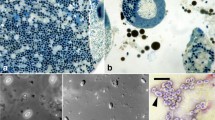Abstract
Nosema manierae sp.n. was first isolated from larvae ofChilo zacconius, then easily transmitted to the corn earworm,Heliothis armigera. In the two lepidopterans, the microsporidian causes a general infection and is highly pathogenic. The life cycle includes binucleate and quadrinucleate meronts and sporonts that divide to form binucleate (diplokaryotic) sporoblasts, typical of the genusNosema. All stages ofN. manierae were studied with the electron microscope.
Résumé
Nosema manierae n. sp. a été découverte dans les larves deChilo zacconius, puis transmise àHeliothis armigera. Dans les deux Lepidoptères, la Microsporidie provoque une infection généralisée et est fortement pathogène. Le cycle de développement comprend des mérontes binucléés et tétranucléés et des sporontes qui se divisent pour donner des sporoblastes binucléés (diplokaryon), typiques du genreNosema. Tous les stades deNosema manierae ont été étudiés en microscopie électronique.
Similar content being viewed by others
References
Berrebi P (1979) Etude ultrastructurale deGlugea atherinae n. sp., Microsporidie parasite de l'Athérine,Atherina boyeri Risso, 1810 (Poisson Téléostéen) dans les lagunes du Languedoc et de Provence. Z. Parasitenkd 60:105–122
Brooks WM (1968) Transovarian transmission ofNosema heliothidis in the corn earworm,Heliothis armigera. J Invertebr Pathol 11:510–512
Brooks WM (1969) Epizootiological observations on the microsporidioses ofHeliothis species and the larval parasitesCampoletis perdistinctus andCardiochiles nigriceps in North Carolina. Soc Invertebr Pathol Neurol 2:26
Brooks WM (1970)Nosema sphingidis sp. n., a microsporidan parasite of the tobacco hornworm,Manduca sexta. J Invertebr Pathol 16:390–399
Brooks WM (1971) The inflammatory response of tobacco hornworm,Manduca sexta to infection by the microsporidian,Nosema sphingidis. J Invertebr Pathol 17:87–93
Canning EU, Sinden RE (1973) Ultrastructural observations on the development ofNosema algerae Vavra and Undeen (Microsporida, Nosematidae) in the mosquitoAnopheles stenphensi Liston. Protistologica 9:405–415
Hall IM (1952) A new species of microsporidia from the fawn-colored lawn moth,Crambus bonifatellus (Hulst) (Lepidoptera, Crambidae). J Parasitol 38:487–491
Hall IM (1954) Studies of microorganisms pathogenic to the sod webworm. Hilgardia 22:535–565
Kellen WR, Hoffmann DF, Collier SS (1977) Studies on the biology and ultrastructure ofNosema transitellae sp. n. (Microsporida, Nosematidae) in the navel orangeworm,Paramyelois transitella (Lepidoptera, Pyralidae). J Invertebr Pathol 29:289–296
Kellen WR, Lindegren JE (1973)Nosema invadens sp. n. (Microsporida: Nosematidae), a pathogen causing inflammatory response in Lepidoptera. J Invertebr Pathol 9:19–25
Kramer JP (1959) OnNosema heliothidis Lutz and Splendore, a microsporidan parasite ofHeliothis zea (Boddie) andHeliothis virescens (Fabricius) (Lepidoptera Phalaenidae). J Invertebr Pathol 1:297–303
Kramer JP (1965)Nosema necatrix sp. n.,Thelohania diazoma sp. n., microsporidians from the armywormPseudaletia unipuncta (Harworth). J Invertebr Pathol 7:117–121
Lipa JJ (1968) Some observations onNosema heliothidis Lutz and Splendore a microsporidian parasite ofHeliothis zea (Boddie) (Lepidoptera, Noctuidae). Acta Protozool 6:273–278
Liu HJ, MacEwen FL (1977)Nosema blissi n. sp. (Microsporida, Nosematidae), a pathogen of the chinch bug,Blissus leucopterus hirtus (Hemiptera, Lygaeidae). J Invertebr Pathol 29:141–146
Lom J, Corliss JO (1967) Ultrastructural observations on the development of the microsporidian protozoonPlistophora hyphessobryconis Schäperclaus. J Protozool 14:141–152
Loubès C (1979) Ultrastructure, sexualité, dimorphisme sporogonique des Microsporidies (Protozoaires). Incidences taxonomiques et biologiques. Thèse US.T.L. Montpellier, p 1–86
Loubès C, Akbarieh M (1978) Etude ultrastructurale de la MicrosporidieBaculea daphniae n.g.n.sp., parasite de l'épithélium intestinal deDaphnia pulex Leydig, 1860 (Crustacé, Cladocère). Protistologica 14:23–38
Loubès C, Maurand J (1976) Etude ultrastructurale dePleistophora debaisieuxi Jirovec (Microsporida): son transfert dans le genreTuzetia Maurand, Fize, Michel et Fenwick, 1971, et remarque sur la structure et la genèse du filament polaire. Protistologica 12:577–591
Lutz A, Splendore A (1904) Über Pebrine und verwandte Mikrosporidien. Nachtrag zur ersten Mitteilung. Zentrabl Bacteriol I Orig 46:645–650
MacLaughlin RE (1969)Glugea gasti sp. n., microsporidian pathogen of the boll weevil,Anthonomus grandis. J Invertebr Pathol 16:84–88
Milner RJ (1972)Nosema whitei, a microsporidian pathogen of some species ofTribolium. I. Morphology, life cycle and regeneration time. II. Ultrastructure. III. Effect onT. castaneum. J Invertebr Pathol 19:231–255
Naegeli (1857) Über die neue Krankheit der Seidenraupe und verwandte Organismen. Bot Ztg 15:760–761
Nordin GL, Maddox JV (1974) Microsporida of the fall webworm,Hyphantria cunea. I. Identification, distribution and comparison ofNosema sp. with similarNosema spp. from other Lepidoptera. J. Invertebr Pathol 24:1–13
Ormières R, Loubès C, Maurand J (1977) Etude ultrastructurale de la MicrosporidiePerezia lankesteriae Leger et Duboscq, 1909, espèce-type: validation du genrePerezia. Protistologica 13:101–112
Ormières R, Baudoin J, Brugerolle G, Pralavorio R (1976) Ultrastructure de quelques stades de la MicrosporidieOctosporea muscaedomesticae Flu., parasite deCeratitis capitata Wiedemann (Diptère Trypetidae). J Protozool 23:320–328
Oshima K (1935) Infectivity ofChilo simplex Butler byNosema bombycis and phagocytic action of the host haemolymphocyte against the parasite. Zool Mag Tokyo 47:607–626
Saftoiu A, Coloianu-Iordachel M (1978) New ultrastructural data on the development of the protozoanNosema lymantriae (Weiser) (Microsporidia) intracellular parasite onLymantria dispar L. (Lepidoptera). Trav Mus Hist Nat “Grigore Antipa” 19:83–87
Sprague V (1977a) Classification and phylogeny of the Microsporidia. Comp Pathobiol 2:1–30
Sprague V (1977b) Annoted list of Microsporidia. Comp Pathobiol 2:31–334
Sprague V (1978) Characterisation and composition of the genusNosema. Miscell Public Entomol Soc Am 11:5–16
Tanabe AM, Tamashiro M (1967) The biology and pathogenicity of a microsporidian (Nosema trichoplusiae sp. n.) of the cabbage looper,Trichoplusia ni (Hübner) (Lepidoptera: Noctuidae). J Invertebr Pathol 9:188–195
Vavra J (1965) Etude au microscope électronique de la morphologie et du développement de quelques Microsporidies. CR Acad Sci 261:3467–3470
Vavra J (1976) Structure of Microsporidia. Comp Pathobiol 1:1–86
Vivarès CP (1978) Grégarinoses et Microsporidioses de Brachyoures (Crustacés, Décapodes) de la Méditerranée Occidentale: aspects cytologiques, biochimiques et physiologiques. Thèse USTL, Montpellier:1–227
Vivarès CP, Bouix G, Manier J-F (1977)Ormieresia carcini gen. n., sp. n., Microsporidie du Crabe méditerranéen,Carcinus mediterraneus Czerniavsky, 1884: Cycle évolutif et étude ultrastructurale. J Protozool 24:83–94
Weiser J (1970) Life cycle ofNosema bombycis. Soc Invertebr Pathol Newsl 2:10
Youssef NN, Hammond DM (1971) The fine structure of the developmental stages of the microsporidianNosema apis Zander. Tissue Cell 3:283–294
Author information
Authors and Affiliations
Rights and permissions
About this article
Cite this article
Toguebaye, BS., Bouix, G. Nosema manierae sp.n., Microsporidie parasite deChilo zacconius Blezenski 1970 (Lepidoptera: Pyralidae), hôte naturel, etHeliothis armigera (Hübner 1808) (Lepidoptera: Noctuidae), hôte expérimental: Cycle évolutif et ultrastructure. Z. Parasitenkd. 69, 191–205 (1983). https://doi.org/10.1007/BF00926954
Accepted:
Issue Date:
DOI: https://doi.org/10.1007/BF00926954



